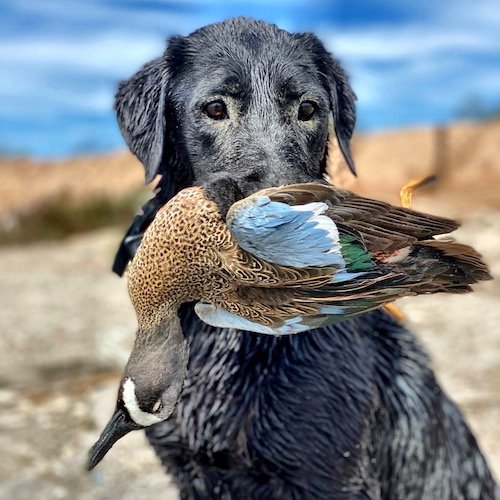Blue-winged Teal

Blue-winged Teal (Spatula discors, formerly Anas discors) are aptly named for the striking sky-blue wing patch visible to us avid hunters while hunting them during the early season, long before they’ve molted. Among the same genus, blue-winged teal, cinnamon teal, and northern shovelers (drakes and hens both) have similar wing plumage with a pale, cobalt blue upper wing patches and dark metallic green speculums separated by a white stripe of secondary coverts. In breeding plumage, blue-winged teal drakes have blue-gray heads with a white crescent moon pattern in front of the eyes. In hand, the gray may even show violet iridescence. Bill is dark gray. Legs are yellow with gray webbing. During the spring, breeding drake blue-winged teal legs are bright yellow. Another distinguishing characteristic is the white patch at the base of the black tail on the drake. Hens have a mottled brown/gray appearance, with adult females having heavy mottled bills. Hens quack, forming a choppy staccato of barks, and this species will respond well to calls.
Available Hunts
-
Texas Teal Hunting – Coastal Prairie
Texas blue-winged teal hunting program is BEST - perfect location and management produce a greater concentration of blue-winged teal than many hunters will witness elsewhere in their lives.
...read more- Best blue-winged teal hunt in US, period
- Limits are the rule, not the exception (5.5 teal per hunter average)
- Short 16-day September season
- Convenient to Houston, Texas
- Executive lodging for 21 guests, southern home-cooked meals
- Youth hunter discounts
- As seen on MOJO TV and in Wildfowl Magazine
Rate: $500 -
Texas Waterfowl Hunt – Desert Paradise
Texas waterfowl hunt packages features relatively unpressured ducks, geese and sandhill cranes in an area so large it takes 3 lodges to cover and so ecologically diverse that most Central Flyway waterfowl species can be hunted!
...read more- Inclusive Texas waterfowl hunting packages for ducks, geese, sandhill cranes, doves, early blue-winged teal, spring turkeys, more.
- 3 lodges to cover vast, relatively undisturbed waterfowl hunting area and to offer flexibility for desired bucket-list species, amenity-level needs, or personal budget
- Central flyway puddle ducks to include prized mottled duck, Mexican duck, cinnamon teal, fulvous whistling duck, black-bellied whistling duck opportunities all right here in USA
- Sandhill crane hunting and white-fronted goose hunting are the Speck Ops Waterfowl house specialties
- Luxurious lodging with over-the-top and fun activities provide fun for bachelor or business hunting groups, entire families and non-hunters,
Rate: $2,000 to $2,900

Blue-winged teal breed exclusively in North America, with the largest congregations found in the prairie potholes portions of Saskatchewan and North and South Dakota. Diet during the breeding season consist mostly of protein-rich foods such as aquatic insects and snails, especially hens who need the protein for egg laying; but they will also consume grains when available. These birds will often migrate from the U.S. before many states are open for the regular duck season, so there is a season specifically for them that opens in September.
Blue-winged teal overwinter down the east coast of North America, in a few southern states (Texas, Louisiana, Mississippi, Alabama, and Florida), all of Mexico and even into South America. Habitat requirements during this time are fulfilled in areas that have vegetated wetlands that have water lilies, a preferred food source, and contain decaying organic matter. There, blue-winged teal diet is dominated by other plant material, including rice and millet.
This species is among the most abundant duck found in North America, second only to the Mallard. Blue-winged Teal populations have remained stable over the past fifty years.




















